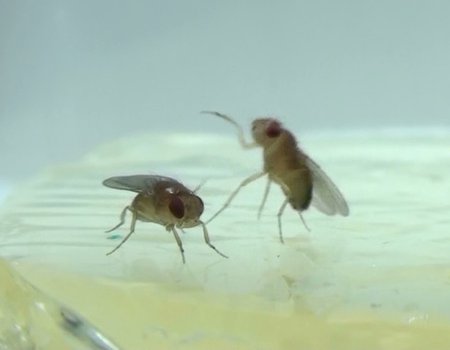You probably behave differently when you are having a bad day than during a great one. For example, while you might politely smile at a neighbor you dislike on an otherwise pleasant Saturday afternoon, that same interaction will elicit a scowl when you are rushing off to work Monday morning. In other words, your brain takes recent experiences into account when coordinating your responses to external stimuli. Even simple animals, like the fruit fly Drosophila melanogaster, do this: Sometimes, a male fly will display high levels of aggression toward another male, while at other times, two male flies can coexist peacefully. All Drosophila brains are wired the same way, so why do the flies exhibit different behaviors when presented with the same sensory cue?
Caltech researchers have now made progress toward understanding the neurological basis of the heightened aggression that male Drosophila show toward one another after recent encounters with females. The study was conducted in the laboratory of David Anderson, Seymour Benzer Professor of Biology, Tianqiao and Chrissy Chen Institute for Neuroscience Leadership Chair and Director, and Howard Hughes Medical Institute Investigator.
When a male fly encounters a female fly, the male often will vibrate his wings in a display of courtship. It is well-established that certain neurons, called P1, are responsible for this predictable courtship behavior and are activated by female scent cues. Once the female is removed from the male's environment, the male's P1 neurons become inactive.
But something about a prior experience with a female causes a male fly to enter into a state of heightened aggressiveness, or arousal, that lingers for a few minutes after the female is gone. Normally, two male flies can coexist in the same area without bothering each other. But male flies who have recently encountered a female will, when encountering another male, show increased displays of aggression: they lunge forward, waving their wings to look larger. Led by graduate student Yonil Jung, a team of Caltech researchers set out to discover how the fly brain encodes for this experience-dependent behavior.
The researchers discovered that once P1 cells are activated by female cues, they in turn activate another set of neurons, called pCd cells. Unlike P1 cells, which shut off as soon as the female is removed, pCd neurons remain active for several minutes. The team found that pCd neurons amplify behavioral effects. If a fly's pCd neurons are active and it encounters another male, it will show increased aggression. Artificially silencing the pCd neurons makes male flies much less aggressive, even after they have encountered a female.
Such a mechanism might have evolved because male flies, in order to fight, have to know that there is both another male present, and that there is a resource to compete over, such as a female. This is not as easy as it would seem, because flies detect other flies—male and female—by touching them with their feet, which bear chemical sensors. Seemingly, a male fly would only know that both another male and a female are present if it touched both of them at the same time (which is very unlikely to happen when flies are actively walking around, for example). The persistent activity of the pCd neurons may give the males a form of "short-term memory" of previous female contact, which helps them decide to fight when they encounter a male.
"It is important to understand how brains encode persistent internal states that outlast the stimuli that trigger them, because such mechanisms may underlie certain forms of memory, as well as emotion and mood states," says Anderson. "Those mechanisms might be affected in memory disorders, or in some psychiatric conditions. The compact nervous system of the fruit fly, and its powerful genetics, makes it a good system to investigate the basic principles underlying forms of persistent activity. Some of them may turn out to apply to mammalian brains such as our own."
The next steps for this work involve studying how pCd neurons stay active even after the female sensory triggers have been removed. Most neurons only fire for milliseconds, but pCd neurons remain active for several minutes. It is still unclear how they stay on, and what induces them to gradually turn off.
A paper describing the research, titled "Neurons that Function within an Integrator to Promote a Persistent Behavioral State in Drosophila," appeared in the December 3 issue of the journal Neuron. In addition to Jung and Anderson, additional co-authors are postdoctoral scholar Ann Kennedy; graduate student Hui Chiu; and Farhan Mohammad and Adam Claridge-Chang of the Institute of Molecular and Cell Biology in Singapore. Funding was provided by the National Institutes of Health and the Howard Hughes Medical Institute.
 One male fly lunges at another in a show of aggression.
Credit: Anderson Lab/Caltech
One male fly lunges at another in a show of aggression.
Credit: Anderson Lab/Caltech


